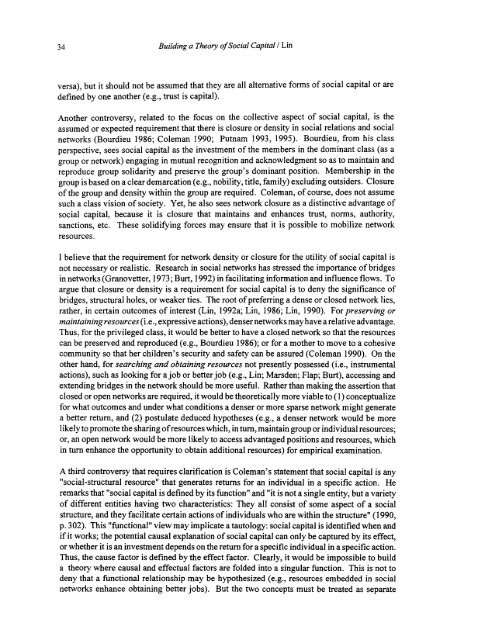Text Analysis of the Social Capital Literature Network ... - INSNA
Text Analysis of the Social Capital Literature Network ... - INSNA
Text Analysis of the Social Capital Literature Network ... - INSNA
Create successful ePaper yourself
Turn your PDF publications into a flip-book with our unique Google optimized e-Paper software.
34 Building a Theory <strong>of</strong> <strong>Social</strong> <strong>Capital</strong> / Lin<br />
versa), but it should not be assumed that <strong>the</strong>y are all alternative forms <strong>of</strong> social capital or are<br />
defined by one ano<strong>the</strong>r (e .g ., trust is capital) .<br />
Ano<strong>the</strong>r controversy, related to <strong>the</strong> focus on <strong>the</strong> collective aspect <strong>of</strong> social capital, is <strong>the</strong><br />
assumed or expected requirement that <strong>the</strong>re is closure or density in social relations and social<br />
networks (Bourdieu 1986 ; Coleman 1990 ; Putnam 1993, 1995) . Bourdieu, from his class<br />
perspective, sees social capital as <strong>the</strong> investment <strong>of</strong> <strong>the</strong> members in <strong>the</strong> dominant class (as a<br />
group or network) engaging in mutual recognition and acknowledgment so as to maintain and<br />
reproduce group solidarity and preserve <strong>the</strong> group's dominant position . Membership in <strong>the</strong><br />
group is based on a clear demarcation (e .g ., nobility, title, family) excluding outsiders . Closure<br />
<strong>of</strong> <strong>the</strong> group and density within <strong>the</strong> group are required . Coleman, <strong>of</strong> course, does not assume<br />
such a class vision <strong>of</strong> society. Yet, he also sees network closure as a distinctive advantage <strong>of</strong><br />
social capital, because it is closure that maintains and enhances trust, norms, authority,<br />
sanctions, etc . These solidifying forces may ensure that it is possible to mobilize network<br />
resources .<br />
I believe that <strong>the</strong> requirement for network density or closure for <strong>the</strong> utility <strong>of</strong> social capital is<br />
not necessary or realistic . Research in social networks has stressed <strong>the</strong> importance <strong>of</strong> bridges<br />
in networks (Granovetter, 1973 ; Burt, 1992) in facilitating information and influence flows . To<br />
argue that closure or density is a requirement for social capital is to deny <strong>the</strong> significance <strong>of</strong><br />
bridges, structural holes, or weaker ties . The root <strong>of</strong> preferring a dense or closed network lies,<br />
ra<strong>the</strong>r, in certain outcomes <strong>of</strong> interest (Lin, 1992a ; Lin, 1986 ; Lin, 1990) . For preserving or<br />
maintaining resources (i .e ., expressive actions), denser networks may have a relative advantage .<br />
Thus, for <strong>the</strong> privileged class, it would be better to have a closed network so that <strong>the</strong> resources<br />
can be preserved and reproduced (e .g ., Bourdieu 1986) ; or for a mo<strong>the</strong>r to move to a cohesive<br />
community so that her children's security and safety can be assured (Coleman 1990) . On <strong>the</strong><br />
o<strong>the</strong>r hand, for searching and obtaining resources not presently possessed (i .e ., instrumental<br />
actions), such as looking for a job or better job (e .g ., Lin ; Marsden ; Flap ; Burt), accessing and<br />
extending bridges in <strong>the</strong> network should be more useful . Ra<strong>the</strong>r than making <strong>the</strong> assertion that<br />
closed or open networks are required, it would be <strong>the</strong>oretically more viable to (1) conceptualize<br />
for what outcomes and under what conditions a denser or more sparse network might generate<br />
a better return, and (2) postulate deduced hypo<strong>the</strong>ses (e .g ., a denser network would be more<br />
likely to promote <strong>the</strong> sharing <strong>of</strong> resources which, in turn, maintain group or individual resources ;<br />
or, an open network would be more likely to access advantaged positions and resources, which<br />
in turn enhance <strong>the</strong> opportunity to obtain additional resources) for empirical examination .<br />
A third controversy that requires clarification is Coleman's statement that social capital is any<br />
"social-structural resource" that generates returns for an individual in a specific action . He<br />
remarks that "social capital is defined by its function" and "it is not a single entity, but a variety<br />
<strong>of</strong> different entities having two characteristics : They all consist <strong>of</strong> some aspect <strong>of</strong> a social<br />
structure, and <strong>the</strong>y facilitate certain actions <strong>of</strong> individuals who are within <strong>the</strong> structure" (1990,<br />
p . 302) . This "functional" view may implicate a tautology : social capital is identified when and<br />
if it works ; <strong>the</strong> potential causal explanation <strong>of</strong> social capital can only be captured by its effect,<br />
or whe<strong>the</strong>r it is an investment depends on <strong>the</strong> return for a specific individual in a specific action .<br />
Thus, <strong>the</strong> cause factor is defined by <strong>the</strong> effect factor . Clearly, it would be impossible to build<br />
a <strong>the</strong>ory where causal and effectual factors are folded into a singular function . This is not to<br />
deny that a functional relationship may be hypo<strong>the</strong>sized (e .g ., resources embedded in social<br />
networks enhance obtaining better jobs) . But <strong>the</strong> two concepts must be treated as separate
















